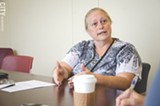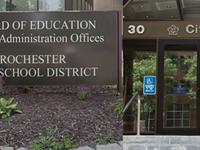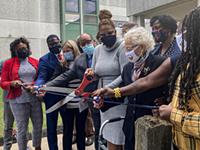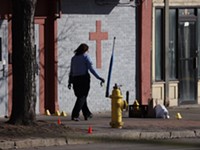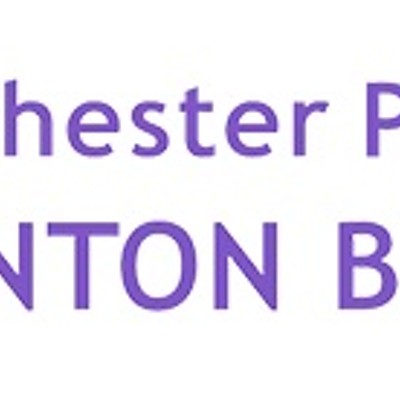[
{
"name": "500x250 Ad",
"insertPoint": "5",
"component": "15667920",
"parentWrapperClass": "",
"requiredCountToDisplay": "1"
}
]
About 4 percent of the Rochester school district's students were arrested at school during the 2008-2009 school year, usually for fights that resulted in charges of disorderly conduct. Among other things, the arrests were symbolic of the public's negative perception of city schools.
But the number of arrests in city schools has fallen significantly over the past several years, apparently due largely to a concerted effort between the district and the Rochester Police Department. The success is both real and hard won, school officials say.
While the trend is a good one, though, district officials don't seem to have all of the information necessary to know specifically what led to the change or how to keep making progress.
The number of students who have been arrested dropped from 1,021 in the 2008-2009 school year to 133 in the 2014-2015 school year, according to data provided to the district from the RPD. And the statistics represent something more important than mere numbers, says Lori Baldwin, the district's director of safety and security.
"When we look at these numbers, these are the number of kids we've placed into the criminal justice system," Baldwin says. "Any time we put a 16- or 17-year old in jail, that's a huge concern."
In 2008, school officials started working with the RPD to figure out why there were so many arrests. They also wanted a better understanding of what school resource officers – city police officers contracted to work in the schools – do, particularly how they interface with students, Baldwin says. The district currently employs 12 SRO's; most of them are stationed in high schools, and they are armed.
Baldwin says they all agreed that they had to drive the number of arrests down. And one of the requirements was ongoing training for the officers to show them how to work in schools with teens, which is different from other work police do out in the community.
"They get a better understanding of teen development," she says. "These are kids, and they are going to act like kids."
In addition, each of the officers was assigned to a single school for the entire school year. "Now they're building a relationship with the kids, and they get to know them by name," Baldwin says. "They may get to know what their home situation is like."
School officials also introduced Student Support Centers in the secondary-level schools, where students can go for help with some of the bigger problems they're having at home or in the community. The district also established Help Zones in most schools, where students and teachers can turn to trained staff if something needs immediate attention – defusing a fight, for example.
Depending on the type of problem the student is having, he or she can receive individual counseling, participate in restorative justice sessions, or be referred to Pathways to Peace counselors. Their parents may also be involved, Baldwin says. The idea is to have alternative resources available to students and building administrators rather than to rely solely on RSO's, and to help students learn how to handle their problems before their behavior spirals out of control, she says.
Fights are by far the most common problem, and a huge emphasis is placed on trying to keep them from leading to a personal injury. Once an assault has occurred, a victim can press charges. That's a turning point where bad behavior becomes criminal behavior, says Baldwin. A single fight can send several teenagers to City Court, and in New York State a 16-year-old can be treated as an adult.
Teachers' union president Adam Urbanski warns against concluding that city schools are safer, though. Nor, he says, do we know what the drop in the number of arrests mean or exactly what has occurred to improve school environments.
"I agree we should minimize children's exposure to the criminal justice system," says Urbanski. "Arrests should never serve as a disciplinary measure. Criminal behavior is not the norm of student misbehavior. It's the exception."
But, he says, last year the number of student assaults on teachers increased. In an average year, there may be 50, but last school year there were 120, Urbanski says. (The district hasn't confirmed that figure.)
And there are other questions. For example, the district doesn't have arrest figures prior to the 2008-2009 school year, so it's hard to know whether that year was a major spike.
And if it was, why? Many school officials believe that year's high number was the result of an edict from former Superintendent Jean-Claude Brizard to end out-of-school suspensions. District officials say that because school administrators couldn't suspend students, the alternative was to send them to study rooms with other misbehaving students, where fights often broke out. But the district doesn't seem to have data to verify that Brizard's plan was the reason for the high arrest number.
School officials also don't have access to basic information like recidivism rates for students who have been arrested more than once. And school officials don't receive thorough data from the court system concerning what happens to students after their arrest.
Even though they don't have data for verification, Baldwin says she believes few students are rearrested, because most of the justices in City Court are equally concerned about keeping students out of the criminal justice system. Frequently, first-time offenders are offered the option of participating in Teen Court, which the district supports financially. The program gives first-time, non-violent offenders the opportunity to have their charges dismissed.
And some school board members have expressed concern about what actions trigger an arrest and whether that correctly matches how police are coding and recording arrests. For instance, does "disorderly conduct" get used as a catchall, regardless of how serious it was?
Still, the drop in arrests is significant. Baldwin agrees that more work is needed to eliminate student arrests. And she says the district's success can easily be undone. She just received figures for the number of arrests for last year and they've ticked upward, she says, though not by a lot. (Baldwin said she wanted to present them to school administrators and board members before making them public.) But it's another reminder of how difficult the challenge is.
Many of the problems students face stem from relationships outside of school – on the streets or at home – and unfold in school, she says. While the culture in each building and the tone set by the principals plays a big role in school safety, a new wave of freshmen enters a high school each year, some of them bringing their own issues with them. And it takes only a few students to destabilize a building, she says.
Speaking of...
Latest in News
More by Tim Louis Macaluso
-

RCSD financial crisis builds
Sep 23, 2019 -

RCSD facing spending concerns
Sep 20, 2019 -

Education forum tomorrow night for downtown residents
Sep 17, 2019 - More »
